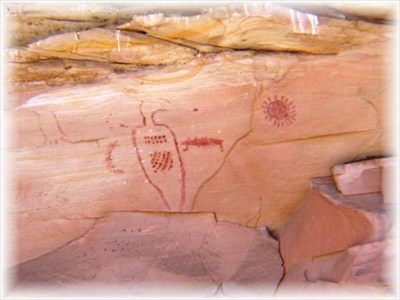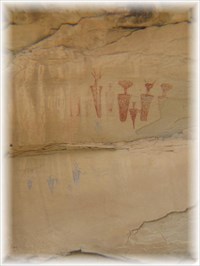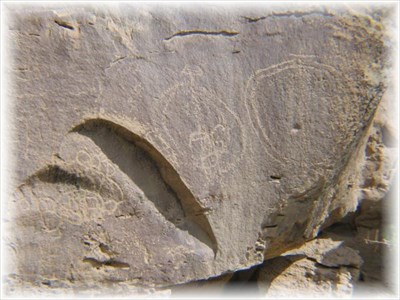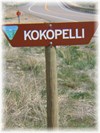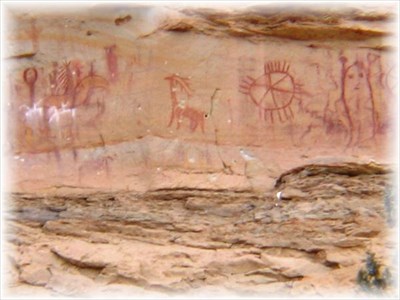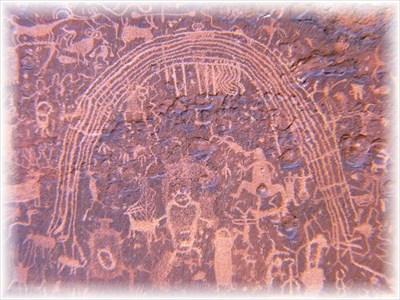N 38° 52.855 W 110° 46.259
12S E 519864 N 4303586
The Head of Sinbad Rock Art is fairly easy to access via dirt and graveled roads off I-70. I would highly recommend a four wheel drive vehicle if you wish to drive right up to the site, otherwise you can drive within about 3/4 mile. Although you can see the interstate from the Rock Art site you can not see the art from the highway! Take the time and explore this region of the San Rafael Swell in southern Utah with several other Rock Art sites nearby and also many Arches and other Historical and Natural wonders. The coordinates listed are directly in front of the cliff along a log fence that prevents vehicles from getting any closer. The Head of Sinbad Rock Art site is actually named for the surrounding rock formations rather than the figures themselves. There are two panels of the Barrier Canyon style on a south facing cliff. These two Pictographs were painted thousands of years ago and the one on the right is still one of the most preserved of this type. The panel on the left is slightly covered from mud flowing from the cliffs above. Native Americans painted and chipped their religious visions, clan symbols, and records of events onto these cliffs. In this region you will find the Barrier Canyon Style - 2000BC; Anasazi - 100BC; Fremont - AD600; and Historic Ute - AD1300-AD1600; Please respect this and all such Rock Art. Also Please Note that the Antiquities Act of 1906 and the Archaeological Resources Protection Act provides serious penalties for vandals. Please Do Not Touch as even the oils in your skin can cause the paints and rock surfaces to deteriorate. If you are in the area you might want to visit some other nearby sites that I will list here. |
Ancient Graffiti
Rock Art Blog
Monday, November 21, 2011
Head of Sinbad Rock Art - Pictographs
Friday, November 18, 2011
McDonald Creek Rock Art - Pictographs
McDonald Creek Rock Art is located in Southwestern Colorado in the United States near these coordinates.
N 39° 09.371 W 109° 01.708
12S E 670349 N 4335959
Located in Western Colorado there are at least four separate panels of Pictographs along the McDonald Creek wash. The area has been renamed the 'McDonald Creek Cultural Resource Area' and is part of the recently renamed 'McInnis Canyons National Conservation Area'. (So much for politicians!) Most folks still just call it 'Rabbit Valley'. There is No Camping in the 'Resource Area' although there is camping available close by. Also I would recommend a high clearance vehicle.
Thanks to the Bureau of Land Management for helping to protect this fragile, prehistoric archaeological site. A few miles south of I-70 you will find the start of a trail and signs pointing you to the locations of the rock art. There is a parking area here and a restroom. Please walk in the stream bed as much as possible as this practice helps prevent development of additional trails. There is more information for this site available at the BLM web site. The coordinates listed here will put you directly in front of the first panel. Please respect this and all such Rock Art. Also Please Note that the Antiquities Act of 1906 and the Archaeological Resources Protection Act provides serious penalties for vandals. Please Do Not Touch as even the oils in your skin can cause the paints and rock surfaces to deteriorate. |
Thursday, November 17, 2011
Carrot Man Rock Art - Pictographs
Carrot Man Rock Art is located in Southwestern Colorado in the United States near these coordinates.
N 39° 56.841 W 108° 53.405
12S E 680247 N 4424045
There are both Pictographs and Petroglyphs at this site with soaring 'carrot men' and other figures located on the roof of an overhang. The Fremont carved and painted interesting carrot-shaped figures and other symbols of unknown meaning as well as pictures of items and events in their lives. You can find Rock Art images of deer, sheep, various other animals, reptiles, birds and corn. Travel south from the town of Rangely, Colorado on a graveled road for about 11 1/2 miles and turn toward the west at the sign. There is a small parking pullout at .3 miles from the sign where you can then take a short walk down a gully to find this Rock Art. Rock Art is Fragile. Please respect this and all such Rock Art. . Please Do Not Touch as even the oils in your skin can cause the paints and rock surfaces to deteriorate. Years of erosion and weathering have taken their toll but people touching the sandstone causes much more damage! The Antiquities Act of 1906 and the Archaeological Resources Protection Act provides serious penalties for vandals |
Cow Canyon Rock Art - Pictographs
Cow Canyon Rock Art is located in Southwestern Colorado in the United States near these coordinates.
N 39° 53.297 W 108° 43.702
12S E 694230 N 4417827
These Pictographs and Petroglyphs are accessible from a turnoff into Philadelphia Draw from Colorado Highway 139 in Western Colorado. After turning East toward Philadelphia Draw you will almost immediately turn South and cross two cattle guards before turning toward the East again. There are several different objects visible at this site from both the Fremont and Ute cultures. Some of the Rock Art objects are difficult to find at first without a trained eye. Take your time and look around. You will notice some vandalism of the Rock Art as well as a few more 'modern' additions. As always with this and other Ancient Rock Art remember that it is very Fragile and deserves our utmost respect. Take only pictures and memories! Do Not Touch as even the oils in your skin can cause the paints and rock surfaces to deteriorate. Erosion and weathering have taken a toll on many of these sites but people touching the sandstone and 'outlining in chalk' causes much more damage! The Antiquities Act of 1906 and the Archaeological Resources Protection Act provides serious penalties for vandals |
Wednesday, November 16, 2011
Kokopelli Rock Art Site - Pictographs
Kokopelli Rock Art Site is located in Colorado, United States near these coordinates.
N 39° 52.439 W 108° 43.921
12S E 693958 N 4416232
The figure of Kokopelli is often associated with Anasazi mythology. His appearance at this site indicates a tie with other civilized cultures in the four corners region of the southwest including the area of Mesa Verde. Some scholars believe that Kokopelli was a traveling trader carrying a pack and entertained his customers by playing his flute. Still others believe him to be a trickster, a seducer of maidens, a fertility symbol, a rain priest, or even a hunting magician! Theories abound but the only real evidence is the Rock Art itself. What do you think?
This site has several interpretive signs for studying the cultural history of the area. The main Kokopelli Rock Art panel has been reinforced to keep it from falling from the cliff face. You will notice a large cable bolted to the rock across Kokopelli's midsection. There are more Freemont and Ute painted and pecked figures at this location. Not much exercise here - very easy access. There is a BLM sign directly along Colorado Highway 139 and a parking area across the road from the Rock Art panels. The listed coordinates are from the parking area directly across from Kokopelli. As always with this and other Ancient Rock Art, remember that it is very Fragile and deserves our utmost respect. Take only pictures and memories! Do Not Touch as even the oils in your skin can cause the paints and rock surfaces to deteriorate. Erosion and weathering have taken a toll on many of these sites but people touching the sandstone and 'outlining in chalk' causes much more damage! The Antiquities Act of 1906 and the Archaeological Resources Protection Act provides serious penalties for vandals |
Tuesday, November 15, 2011
Three Canyons Rock Art - Pictographs
|
Three Canyons Rock Art is located in Southeastern Utah in the United States near these coordinates.
N 39° 16.496 W 109° 17.101
12S E 647931 N 4348688
The listed coordinates are from a parking pullout along the main dirt road into the area. Please Respect the Private Property on both sides of the road at this particular point. Look toward your left(west) and up for the first panels. You will reenter BLM land a few 100 yards further. Look toward your right for a number of Pictographs(painted rock) across the wash. The road does continue for many miles where it branches from Hay Canyon to Dark Canyon. This is very rugged country and mostly used by oil and gas field workers as well as hunters. For viewing the Petroglyphs(carved stone) you should return to the junction of Hay and East Canyons and follow the road into East Canyon. Look toward your left for a close view of the Rock Art typical of this area. Please Note that even in this remote location that some of the panels have been vandalized by thoughtless individuals including some photographers who think that outlining the art in chalk is a 'good thing'. Just Don't! You will also notice a few more 'modern' additions. There are no signs indicating that this Rock Art exists. There are 2 somewhat main routes into the area, one from I-70 and the easiest off old HWY 6. Both roads meet at the sign posted here in the Gallery. Native Americans painted and chipped their religious visions, clan symbols, and records of events onto these cliffs. Specifically the Barrier Canyon Style - 2000BC; Anasazi - 100BC; Fremont - AD600; Historic Ute - AD1300-AD1600; If you are in the area you might want to visit some other nearby sites that I will list here. And Please Remember that the Antiquities Act of 1906 and the Archaeological Resources Protection Act provides serious penalties for vandals. Please Do not touch as even the oils in your skin can cause the paints and rock surfaces to deteriorate. |
Monday, November 14, 2011
Rochester Creek Rock Art - Pictographs
Rochester Creek Rock Art is located in Southern Utah near these coordinates.
N 38° 54.186 W 111° 11.880
12S E 482831 N 4306042
The Rochester Creek Rock Art is easy to access via a maintained gravel road. There is a good sized parking area and a short half-mile hike to reach the site. Towns are few and far between. There is ‘primitive’ camping available in the immediate area.
The Rochester Creek Rock Art is thought to be of the Barrier Canyon style. The Barrier Canyon style is generally known for its painted human like figures also found in several locations in the surrounding area. The main panel here is crowded with many pictures of animals including elk, a snake, a spider, and other odd looking creatures. The main standout figure is that of the 'Rainbow' which is around four feet tall and thought to represent the galaxy and constellations.
Native Americans painted and chipped their religious visions, clan symbols, and records of events onto these cliffs. In this region you will find the Barrier Canyon Style - 2000BC; Anasazi - 100BC; Fremont - AD600; and Historic Ute - AD1300-AD1600;
Please respect this and all such Rock Art. Also Please Note that the Antiquities Act of 1906 and the Archaeological Resources Protection Act provides serious penalties for vandals. Please Do Not Touch as even the oils in your skin can cause the paints and rock surfaces to deteriorate.
If you are in the area you might want to visit some other nearby sites that I will list here.
|
Subscribe to:
Comments (Atom)

